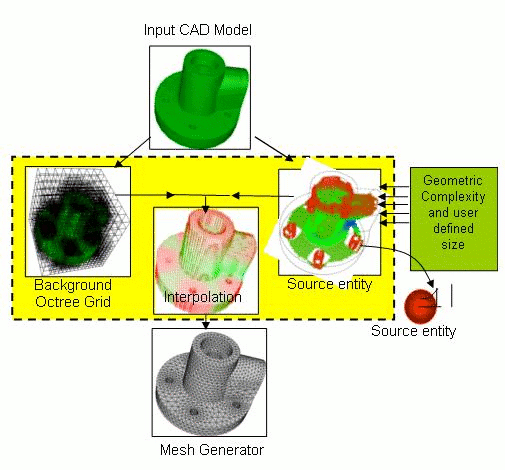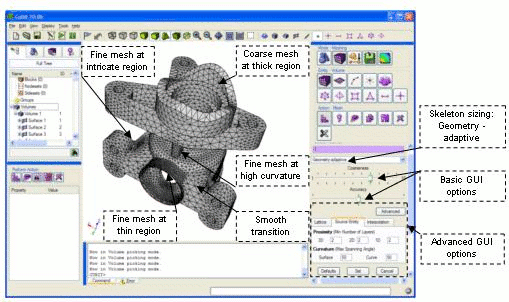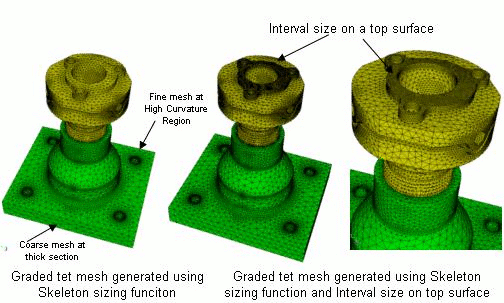![]()
Coreform Cubit 2025.8 User Documentation
![]()
The Geometry Adaptive Sizing Function, also referred to as the Skeleton Sizing Function (Quadros 2005; Quadros 2004; Quadros 2004(2)), automatically generates a mesh sizing function based upon geometric properties of the model. This sizing scheme attempts to create a sizing function that allows unstructured meshing schemes to generate a mesh with the following properties:
The geometry adaptive sizing function can be used to create sizing information for surfaces, solids, and assemblies.
This sizing function uses geometric properties to influence mesh size. The scheme calculates or estimates:
These properties are then used to calculate a sizing function throughout the geometric entity (or entities). Regions of relatively high complexity will have a fine mesh size, while regions of relatively low complexity will have a coarse mesh size. For example, generally, a high-curvature region on a surface will have a finer mesh size than a low-curvature region on that surface

Figure 1: Overview of Computational Framework

Figure 2: Skeleton Sizing Function example in the GUI
Skeleton sizing can be specified on single or multiple surface(s)/volume(s) at a time from the GUI (Meshing Control Panel) or the command-line. The following describes how specifying sizing on entities can change skeleton sizing’s behavior:
Single surfaces/volumes – If skeleton sizing is applied to surfaces/volumes one at a time, each entity’s sizing is not influenced by the others. On the command-line, issue a separate command for each entity. In the GUI, specify only one surface or volume before selecting “Apply Size”.
Multiple surfaces – If skeleton sizing is applied on multiple surfaces together, then geometric features of a particular surface may affect its neighboring surfaces.
Multiple volumes (assembly sizing) – Skeleton sizing can be applied to assembly models so that geometric features of a volume may influence its neighbors. Volumes should first be imprinted and merged before they are specified together for skeleton sizing.
Surface <surface_id_range> Sizing Function Skeleton
{[scale <1 to 10 = 7>] [time_accuracy_level <1 to 3 = 2>]
[min_depth <3 to 8 = 5>] [max_depth <4 to 9 = 7>] [facet_extract_ang <1 to 30 = 10>]
[min_num_layers_2d < 1 to N = 1>] [min_num_layers_1d < 1 to N = 1>]
[max_span_ang_surf <5.0 to 75.0 = 45.0 degrees>]
[max_span_ang_curve <5.0 to 75.0 = 45.0 degrees>]
[min_size <float>] [max_size <float>] [max_gradient <float=1.5>]}
Skeleton sizing on volumes:
Volume <range> Sizing Function Skeleton
{[scale <1 to 10 = 7>] [time_accuracy_level <1 to 3 = 2>]
[min_depth <3 to 8 = 5>] [max_depth <4 to 9 = 7>] [facet_extract_ang <1 to 30 = 10>]
[min_num_layers_3d < 1 to N = 1>] [min_num_layers_2d < 1 to N = 1>]
[min_num_layers_1d < 1 to N = 1>]
[max_span_ang_surf <5.0 to 75.0 = 45.0 degrees>]
[max_span_ang_curve <5.0 to 75.0 = 45.0 degrees>]
[min_size <float>] [max_size <float>] [max_gradient <float=1.5>]}
The options are explained below:
The skeleton sizing function is generated and stored on a background octree grid whose cells are subdivided based on the graphics facets of the model. The level of subdivision of the background grid affects how well the sizing function captures the geometric complexity of features. Reasonable defaults have been selected for the following two refinement (subdivision) parameters, but these may be overridden for use with simple (decrease parameters) or more complex (increase parameters) models.
Note: These arguments override the basic arguments. For example, time accuracy level 1 internally sets min_depth = 4 and max_depth = 6, and when min_depth is set to 4 and max_depth is set to 7 in the advanced options (recommended for models with fine features), then advanced options override the basic options. In the command-line, to override the depths set by a time_accuracy_level, specify min_depth and max_depth after it.
Skeleton sizing function gives an option to manually add sizing sources on geometric entiies such as vertices, curves, and surfaces. These sizing sources control the size and scope (region of influence via num_layers) at geometric entities. The below command gives the syntax for adding sizing sources. Please note that the below command for adding sizing sources should be called after issuing the above given skeleton sizing command. First, the skeleton sizing command automatically generates sizing sources based on the geometric factors such as proximity, surface curvature, curve length, etc. Issuing the below command creates sizing sources in addition to the automatically generated sizing sources. Finally, when the meshing command is called, the mesh sizing function is calculated using all the sizing sources.
Volume <vol_id_range> Sizing Function Skeleton add size_source {vertex|curve|surface} <id_range> size <double> num_layers <int>
Skeleton sizing function produces a smooth sizing function when called with other sizing controls available in Coreform Cubit. Skeleton sizing function behaves as SOFT firmness level. Skeleton sizing function always respects interval count specified on the curves. Skeleton sizing function respects interval size on curves and surfaces only if it is specified after calling the skeleton sizing function.

Figure 3: Skeleton sizing function with other sizing controls